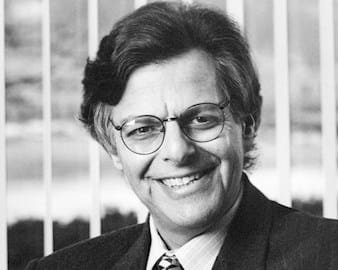
1962
Earned a bachelor's degree in economics from McMaster University
1962
Myron S. Scholes developed a method of determining the value of derivatives, the Black-Scholes formula, with Fischer Black, who died two years before Scholes was recognized with the Nobel Prize. This methodology paved the way for economic valuations in many areas. It also generated new financial instruments and facilitated more-effective risk management in society.
Scholes is widely known for his seminal work in options pricing, capital markets, tax policy, and the financial services industry. He is the Frank E. Buck Professor of Finance Emeritus at the Stanford University Graduate School of Business.
Scholes is also the chief investment strategist at Janus Henderson Investors, and is chairman of the board of economic advisors of Stamos Capital Management. He previously served as chairman of Platinum Grove Asset Management, which he cofounded in 1999, as well as on the Dimensional Fund Advisors board of directors.
Scholes was born in 1941 in Timmins, Ontario. He became interested in economics through his parents and relatives. As a young man, he developed an eyesight impairment. In his Nobel Prize autobiography, Scholes recalled that as a result of his limited ability to read for extended periods of time, “I learned to think abstractly and to conceptualize the solution to problems. Out of necessity, I became a good listener—a quality appreciated by subsequent associates and students.” Luckily, an operation when he was 26 years old improved his eyesight.
While at McMaster University, where he majored in economics, Scholes became acquainted with the work of George Stigler and Milton Friedman. Scholes enrolled at the University of Chicago and studied with Eugene F. Fama and Merton Miller, while earning his MBA at Booth in 1964 and his PhD in 1970.
In 1968, as he was wrapping up work on his PhD, Scholes accepted a job as an assistant professor of finance at MIT’s Sloan School of Management. At Sloan, he met Fischer Black, at the time a consultant working for management consultant firm Arthur D. Little, and the two embarked on a productive research partnership.
After a visiting stint at the University of Chicago during 1973-74, Scholes returned to his graduate institution as the Edward Eagle Brown Professor of Finance at Booth from 1974 until 1983. During that time, he also became involved with the Center for Research in Security Prices (CRSP), where he served as director.
In 1983, Scholes moved to the Stanford Graduate School of Business.

“My first reaction on being awarded the Nobel Prize was, actually, I thought of Fischer Black, my colleague. He unfortunately had passed away. And there was no doubt in my mind that if he were still alive, he would have been a corecipient of the Nobel Prize.”
—Myron S. Scholes
In their Nobel Prize–winning work, Robert C. Merton and Myron S. Scholes “have, in collaboration with the late Fischer Black, developed a pioneering formula for the valuation of stock options. Their methodology has paved the way for economic valuations in many areas. It has also generated new types of financial instruments and facilitated more efficient risk management in society,” the Nobel Committee wrote in awarding the 1997 prize.
“This year’s laureates, Robert Merton and Myron Scholes, developed this method in close collaboration with Fischer Black, who died in his mid-fifties in 1995,” the committee wrote. “These three scholars worked on the same problem: option valuation. In 1973, Black and Scholes published what has come to be known as the Black-Scholes formula. Thousands of traders and investors now use this formula every day to value stock options in markets throughout the world. Robert Merton devised another method to derive the formula that turned out to have very wide applicability; he also generalized the formula in many directions.”
Scholes is also known for his work on the effects of global tax policies on decision-making. In 1992, he coauthored the book Taxes and Business Strategy, with Mark Wolfson.